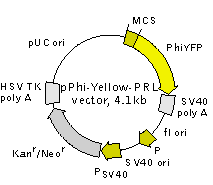
|
||||||||||
|
||||||||||

|
|
|||||||||||||||||||||||||||||||||||||||||||||||||||||||||||||||||||||||||||||||||||||||||||||||||||||||||||||||||||||||||||||||||||||||||||||||||||||||||||||||||||||||||||||||||||||||||||
The vector sequence has been compiled using the information from sequence databases, published literature, and other sources, together with partial sequences obtained by Evrogen. This vector has not been completely sequenced. |
|||||||||||||||||||||||||||||||||||||||||||||||||
 Download
|
| ||||||||||||||||||||||||||||||||||||||||||||||||
| Bgl II* | Sac I | Hind III | EcoR I | Sal I | Kpn I | Apa I | BamH I | Age I | PhiYFP | |||||||||||||||||
| Afe I | Xho I | Pst I | Sac II* | |||||||||||||||||||||||
| ...T | A.GCG.CT | A.CCG.GAC.TC | A.GAT. | CT | C. | GAG. | CTC. | AAG.CTT. | C | GA.ATT. | C | TG.CA | G. | TCG.AC | G.GTA. | CC | G.C | GG. | G | CC.C | G | G.G | AT.CC | A.CCG.GT | C.GCC.ACC. | ATG... |
* – not unique site.
Vector description
pPhi-Yellow-PRL is a promoterless vector encoding yellow fluorescent protein PhiYFP, which can be used as in vivo reporter of promoter activity (see reporter description). PhiYFP codon usage is optimized for high expression in mammalian cells (humanized) [Haas et al., 1996]. To increase mRNA translation efficiency, Kozak consensus translation initiation site is generated upstream of the PhiYFP coding sequence [Kozak, 1987].
Multiple cloning site (MCS) is located upstream of the Kozak consensus translation initiation site and can be used to clone a promoter or a promoter/enchancer combination of interest. Without the addition of a functional promoter, this vector will not express PhiYFP.
The vector backbone contains SV40 origin for replication in mammalian cells expressing SV40 T-antigen, pUC origin of replication for propagation in
SV40 early promoter (PSV40) provides neomycin resistance gene (Neor) expression to select stably transfected eukaryotic cells using G418. Bacterial promoter (P) provides kanamycin resistance gene expression (Kanr) in
Note: The plasmid DNA was isolated from dam+-methylated
Propagation in
Suitable host strains for propagation in
Location of features
MCS: 12-89
PhiYFP
Kozak consensus translation initiation site: 90-100
Start codon (ATG): 97-99
Stop codon: 799-801
SV40 early mRNA polyadenylation signal
Polyadenylation signals: 1015-1020 & 1044-1049
mRNA 3' ends: 1053 & 1065
f1 single-strand DNA origin: 1112-1567
Bacterial promoter for expression of Kanr gene
-35 region: 1629-1634
-10 region: 1652-1657
Transcription start point: 1664
SV40 origin of replication: 1908-2043
SV40 early promoter
Enhancer (72-bp tandem repeats): 1741-1812 & 1813-1884
21-bp repeats: 1888-1908, 1909-1929 & 1931-1951
Early promoter element: 1964-1970
Major transcription start points: 1960, 1998, 2004 & 2009
Kanamycin/neomycin resistance gene
Neomycin phosphotransferase coding sequences:
Start codon (ATG): 2092-2094
Stop codon: 2884-2886
G->A mutation to remove Pst I site: 2274
C->A (Arg to Ser) mutation to remove BssH II site: 2620
Herpes simplex virus (HSV) thymidine kinase (TK) polyadenylation signal
Polyadenylation signals: 3122-3127 & 3135-3140
pUC plasmid replication origin: 3471-4114
References:
Notice to Purchaser:
PhiYFP-related materials (also referred to as "Products") are intended for research use only. The Products are covered by U.S. Pat. 7,951,923; European Pat. 03779067; and other Evrogen Patents and/or Patent applications pending. By use of these Products, you accept the terms and conditions of the applicable Limited Use Label License.
|
Copyright 2002-2023 Evrogen. All rights reserved. Evrogen JSC, 16/10 Miklukho-Maklaya str., Moscow, Russia, Tel +7(495)988-4084, Fax +7(495)988-4085, e-mail:evrogen@evrogen.com |


